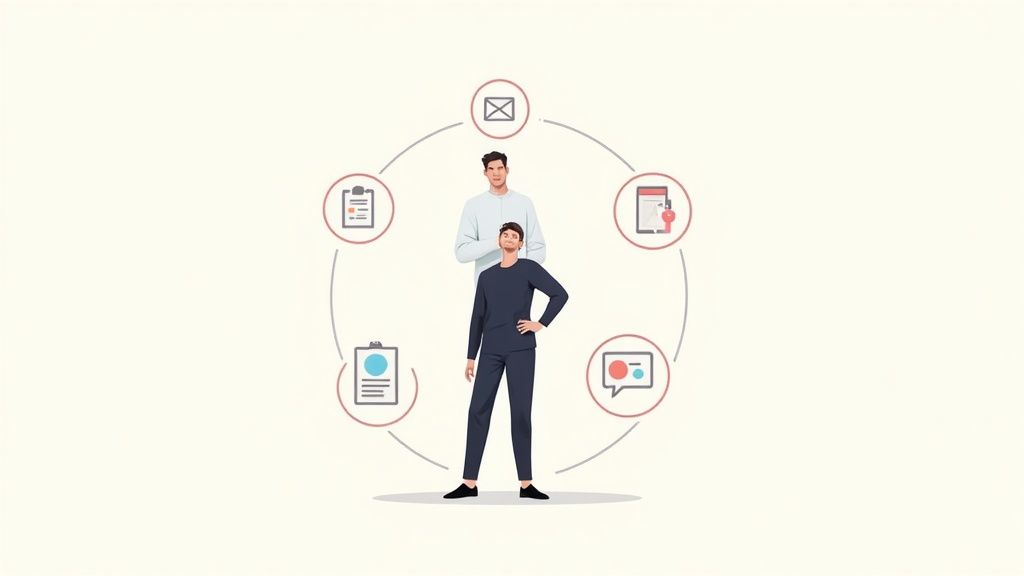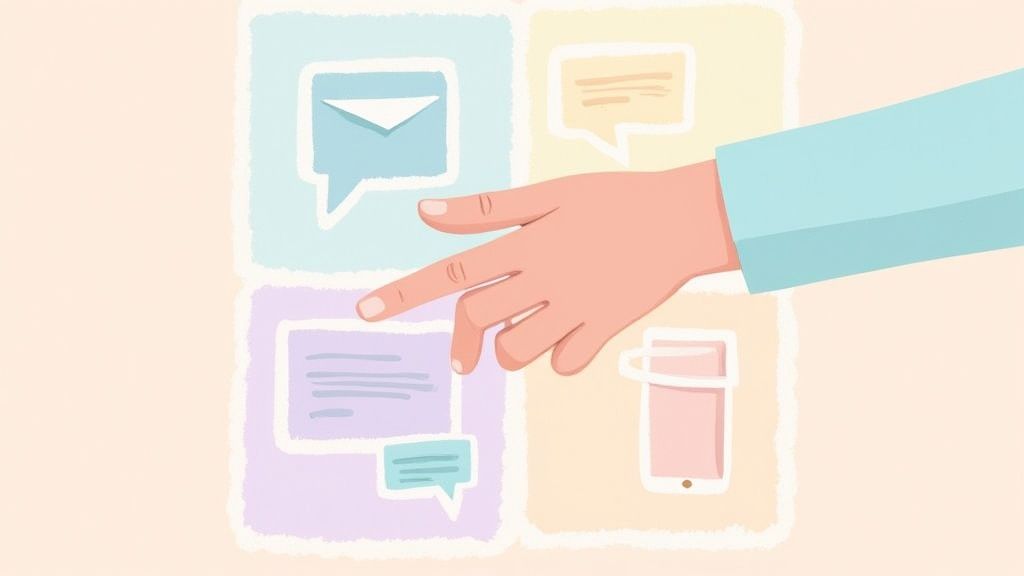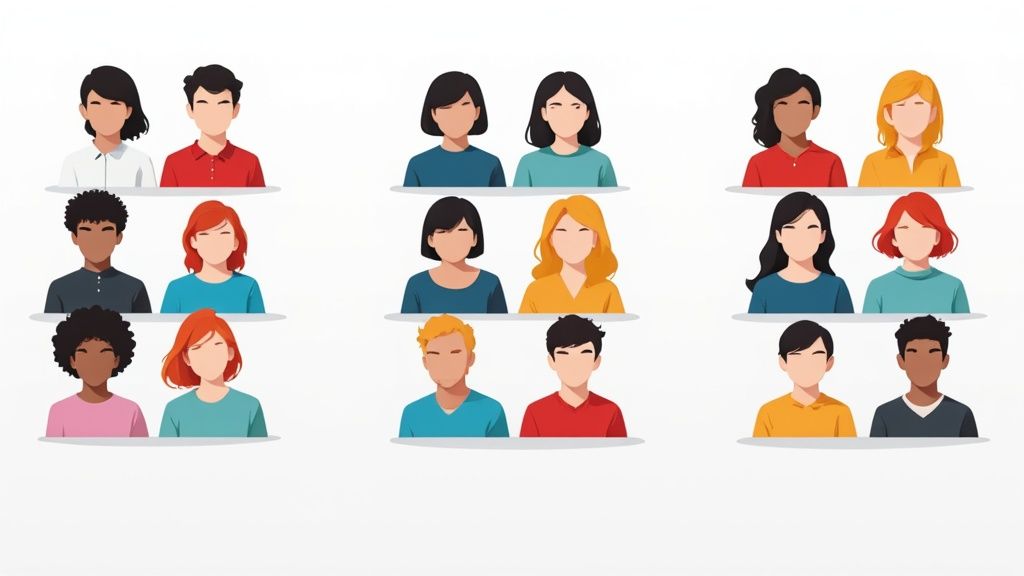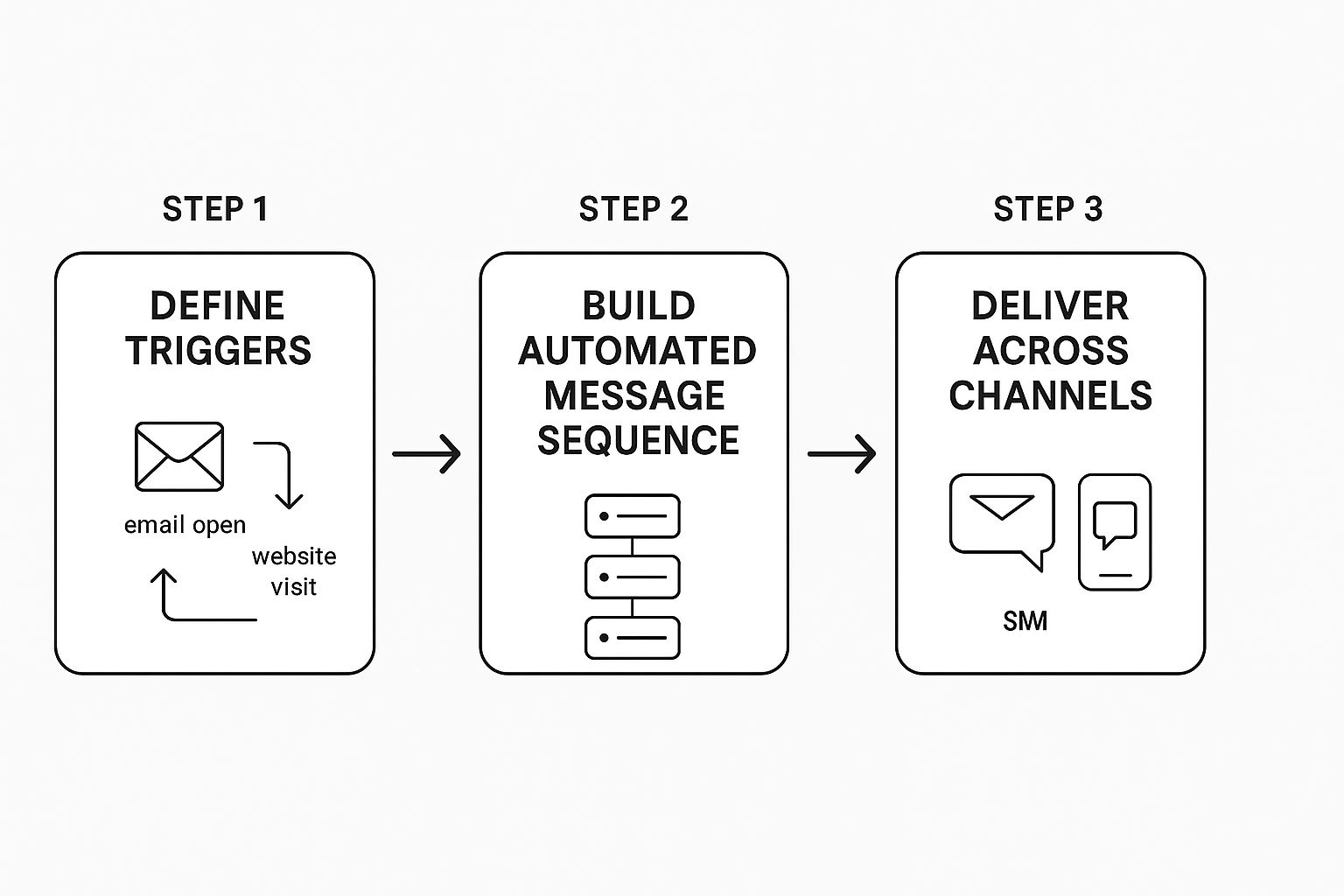Mastering Multi Channel Campaign Management

Ever feel like you're shouting into the wind with your marketing? You've got a great message, but it seems to get lost in the noise. That's what happens when your marketing efforts are scattered and disconnected.
What Is Multi Channel Campaign Management Anyway?
Imagine you're trying to put on a great show. You've got a killer band, but the guitarist is playing heavy metal, the singer is crooning a ballad, and the drummer is laying down a jazz beat. It’s just noise, not music. This is what marketing can feel like without a unified plan.

Multi channel campaign management is how you get everyone playing from the same sheet music. It's the art of coordinating your message across different platforms so that it’s consistent and clear, whether someone sees it on X, in an email, or on Discord.
The logic is simple: your community isn’t hanging out in just one spot online. They might find your Web3 project through a post on X (formerly Twitter), get hyped from your newsletter, and then jump into your Discord to connect with other members. A multi channel approach means you’re right there with them at every step, creating more touchpoints and opportunities to engage.
Differentiating Your Marketing Approaches
It’s easy to get tangled in marketing jargon. People often throw around terms like "multi channel" and "omni channel" as if they're the same thing, but they’re not. Multi channel is all about being available on many platforms, while omni channel is about making the experience seamlessly connected between those platforms.
A multi channel approach is about casting the widest net possible to get maximum customer engagement. It’s a strategy focused on presence and reach, making sure your brand is visible wherever your audience might be looking.
To really nail this down, let's look at how the main marketing strategies stack up against each other. Each one has a different goal—single-channel is all about focus, multi-channel is about breadth, and omni-channel is about creating a truly unified journey.
Here's a quick comparison to make things crystal clear.
Single Channel vs Multi Channel vs Omni Channel Marketing
| Approach | Channel Strategy | Customer Experience | Primary Goal |
|---|---|---|---|
| Single Channel | Focuses on one primary channel (e.g., only email or only social media). | The experience is confined to a single platform. | Master one channel to maximize its specific audience and ROI. |
| Multi Channel | Uses multiple, independent channels to engage with customers. | Channels operate in parallel; the experience on one doesn't directly affect another. | Maximize reach and provide customers with multiple options to connect. |
| Omni Channel | Integrates multiple channels to create a unified, seamless journey. | Channels work together; a customer can start on mobile and finish on desktop without friction. | Create a holistic and consistent customer-centric experience. |
At the end of the day, multi channel campaign management is a game-changer. It’s the essential first step away from relying on a single point of contact and toward building brand recognition and trust across the places your audience actually spends their time. This is how you start building a smart, modern marketing machine that actually drives growth.
Why a Multi-Channel Approach Is No Longer Optional
Let's face it: the customer journey isn't a straight line anymore. It's a messy, winding path that zigs and zags between TikTok videos, email newsletters, Discord communities, and a quick recommendation from a friend. People don't live on a single platform, so why should your brand?

Trying to grow with a single channel is like fishing with one tiny net in a huge ocean. Sure, you might catch something, but you're ignoring all the other fish swimming just a few feet away. A solid multi-channel campaign management strategy means you show up where your audience is already hanging out, building familiarity and trust with every little interaction.
Think about it from a user's perspective. Maybe they see an ad for your new Web3 game on X. A few days later, an email lands in their inbox showing off its killer features. Then, they see a friend hyping it up in a Discord server. This consistent, multi-pronged approach is what turns a fleeting moment of curiosity into a real desire to join your community.
The Real Cost of a Disconnected Experience
When your channels aren't in sync, users feel it immediately. Imagine someone clicks an ad for early access to a new feature, only to be dumped on a generic homepage that doesn't mention the offer. What do they do? They get confused, feel like you wasted their time, and bounce. That's a lost lead, all because of a simple disconnect.
On the flip side, a connected experience can turn a casual browser into a die-hard fan. When that same ad click leads to a dedicated landing page and is followed up with a welcome email that actually references their interest, the user feels seen and understood. This smooth flow is the heart and soul of effective multi-channel campaign management.
The goal is to make every touchpoint feel like a natural continuation of the last, guiding the user smoothly through their journey without forcing them to reconnect the dots themselves.
This kind of consistency is everything. It's not about just blasting the same message everywhere. It's about tailoring your story to fit the vibe of each platform while keeping your core brand identity intact. For new projects, getting this right is a huge part of building successful user acquisition strategies.
Core Benefits of an Integrated Approach
Okay, enough with the theory. A well-oiled multi-channel strategy delivers real, measurable results. It’s about more than just being visible; it’s about being effective.
Here’s what you really gain:
- Wider Audience Reach: By being on different channels, you connect with different groups of people. The crowd you find on Telegram might be completely different from your email subscribers.
- Consistent Brand Storytelling: Repetition builds recognition. When people see your brand consistently across platforms, it cements your message and makes your identity much more memorable.
- Richer Customer Insights: Every channel is a new source of data. When you pull all those data points together, you get a much clearer picture of what your users want, how they behave, and what their problems are. That's how you make smarter marketing decisions.
The sheer scale of the opportunity here is staggering. By 2025, there will be an estimated 5.42 billion social media users worldwide. And it's not just about numbers—a whopping 86% of marketers report that using multiple channels makes their campaigns significantly more effective. This isn't just a fleeting trend; it’s a fundamental shift in how great brands connect with people in our hyper-connected world.
Building Your Winning Multi-Channel Strategy
Alright, so you get the idea of multi-channel campaign management. But how do you actually put it into practice? Moving from theory to a real-world, winning strategy isn't about just showing up on every platform you can think of. It’s about building a system where every channel has a job and works in harmony with the others.
Think of it like coaching a sports team. You don't just throw your best players on the field and hope for the best. You need a game plan.

Without a clear playbook, your efforts will feel disjointed. You'll waste time and money, and worst of all, you'll just confuse your community. The secret is to build your strategy on four key pillars that make sure every part of your campaign is pulling in the same direction.
Let’s break them down.
Create a Unified Customer View
You simply can't create a connected experience if you don't have a connected view of your user. This means bringing together all the data points from every interaction—their social media comments, email clicks, website visits, and on-chain activities—into a single, easy-to-read profile.
When your data is siloed, you only see bits and pieces of the story. Your email platform knows who opened a newsletter, but it has no idea that same person just followed your project on X. That's a huge missed opportunity. For instance, a user who just liked your latest feature announcement is the perfect person to get a follow-up email with a tutorial.
A unified view transforms your marketing from a series of isolated guesses into a sequence of intelligent, data-driven conversations. It’s the difference between shouting into a crowd and speaking directly to an individual.
Having this single source of truth lets you see the full user journey and make much smarter moves. It's the bedrock of any solid multi-channel strategy.
Maintain Consistent and Adapted Messaging
Consistency builds trust. Simple as that. When your brand's voice, tone, and message feel the same everywhere, you come across as reliable and professional. But—and this is a big "but"—consistency does not mean copy-pasting the same post on every channel. That's a rookie mistake that completely ignores what makes each platform unique.
The real goal is adapted consistency. Your core message stays the same, but you change how you deliver it to fit the channel.
- On X (formerly Twitter): Your message has to be punchy, quick, and designed to get an immediate reaction.
- Via Email: You’ve got more room to breathe. Tell a story, dive into the details, and guide people with a clear call-to-action.
- In a Discord Community: Here, the vibe is way more casual and conversational. It's all about direct interaction and building that community feel.
Think of your brand like a person. You wouldn't talk to your best friend the same way you'd talk in a big presentation, but you're still the same person, right? That’s exactly how your brand should feel online.
Picking the right channels is half the battle. Here's a quick look at some common B2C channels and how they fit into a larger strategy.
Essential Channels for a Modern B2C Campaign
| Channel | Primary Use Case | Key Metric to Track |
|---|---|---|
| Email Marketing | Nurturing leads, announcing updates, driving conversions | Click-Through Rate (CTR) |
| Social Media (X, Insta) | Building brand awareness, community engagement, top-of-funnel | Engagement Rate |
| Community (Discord, TG) | Fostering loyalty, direct user feedback, support | Active Members |
| Content Marketing (Blog) | Educating users, establishing authority, SEO | Organic Traffic |
| Paid Ads (Google, FB) | Reaching new audiences, retargeting, direct acquisition | Cost Per Acquisition (CPA) |
This table just scratches the surface, but it shows how each channel should have a distinct purpose while contributing to the overall goals.
Use Centralized Campaign Orchestration Tools
Trying to manually juggle campaigns across a half-dozen platforms is a nightmare. It’s a one-way ticket to burnout, mistakes, and missed opportunities. To really nail a multi-channel strategy, you need a central command center. This is where tools built for multi-channel campaign management come in.
A centralized platform lets you design, schedule, and track all your campaigns from one dashboard. It makes your channels "talk" to each other, which allows for powerful automations that are impossible to do by hand. For example, a tool like Domino can automatically grant a user a new Discord role the moment they complete an on-chain action, with zero manual work from your team.
This is what real orchestration looks like. You're no longer just managing channels; you're conducting a symphony of coordinated actions that guide users perfectly along their journey.
Implement Integrated Analytics and Measurement
Last but not least, you can't improve what you don't measure. A winning strategy needs integrated analytics to see what's actually working across all your channels, not just in silos. The goal here is to stop obsessing over channel-specific vanity metrics (like likes or opens) and start focusing on how your combined efforts are moving the needle on big-picture goals like user acquisition and retention.
When your analytics are connected, you can finally answer the important questions. Which combination of channels brings in the most valuable users? How does a spike in Discord engagement affect email sign-ups? Where in the journey are people dropping off? This holistic view is how you find your winning plays, optimize your budget, and finally prove the ROI of your hard work.
Your Step-By-Step Campaign Workflow
Knowing the theory behind multi-channel campaign management is one thing, but the real magic happens when you turn that knowledge into a repeatable process. A solid workflow removes the guesswork, making sure every move you make is deliberate and tied directly to your main goals.
Think of it like a pilot's pre-flight checklist. They don't just hop in the cockpit and hope for the best. They follow a precise sequence to guarantee a smooth flight. This five-step process is your sequence for launching campaigns that actually hit their mark.
1. Define Your Core Goal And KPIs
Before you write a single word of copy or even think about which channel to use, you have to know what winning looks like. What are you actually trying to do? A fuzzy goal like "increase engagement" is pretty much useless. You need a sharp, measurable goal to build your entire strategy on.
Are you trying to drive sign-ups for a new feature? Grow your Discord community by 1,000 members? Boost sales of a specific NFT collection? Get crystal clear on that one core goal.
Once that's locked in, define the Key Performance Indicators (KPIs) that will tell you if you're on the right track.
- For user acquisition: Keep an eye on Cost Per Acquisition (CPA) and Conversion Rate.
- For community growth: You’ll want to monitor New Members and the Active User Rate.
- For engagement: Measure things like Click-Through Rate (CTR) and how many on-chain actions people are completing.
If you skip this step, you're just making noise. But if you nail it, every decision you make from here on out has a clear purpose.
2. Identify And Segment Your Audience
The single biggest mistake in marketing is trying to talk to everyone at once. When you speak to everyone, you end up connecting with no one. The trick is to figure out who your ideal user is and then slice them into smaller, more focused groups based on what they do and what they care about.
Are you targeting your power users, brand new members, or maybe the folks who’ve shown interest but haven't taken the plunge? Each of these groups needs a slightly different message and a different path. A new user, for example, needs educational content to get up to speed. A loyal fan, on the other hand, might be more interested in an exclusive offer.
Your audience doesn't care about your product; they care about their problems. Effective segmentation allows you to frame your message in a way that shows how you solve their specific problem, making it instantly more relevant.
3. Select Channels And Map The Journey
Okay, you've got your goals and you know who you're talking to. Now it's time to choose your battlegrounds. Where does your audience actually hang out online? A "spray and pray" approach across a dozen channels is just a fast way to burn through your budget. Focus your energy where it’ll have the biggest impact.
Today's customer journey isn't a straight line. Marketers are now juggling campaigns across an average of five different channels. Platforms like email (used by 78.8% of marketers) and social media (74.3%) are still the heavy hitters for connecting with users wherever they are. If you want to dive deeper, you can explore the full breakdown of omnichannel marketing statistics.
Once you’ve picked your channels, map out how a user will move from one to the next. For instance, someone might see your project in a paid ad on X, click to a landing page to sign up for your newsletter, and then get a welcome email inviting them to your Discord. Each touchpoint should feel like a natural next step.
4. Create And Tailor Your Content
Now for the fun part. Using your audience segments and channel choices as your guide, you'll start creating content that speaks directly to each group. The key here is adapted consistency—your main message stays the same, but you tweak the delivery to fit the vibe of each platform.
That hilarious GIF that killed it on X isn't going to work in a formal email. That in-depth blog post? It needs to be chopped into bite-sized tips for a Telegram announcement. This kind of thoughtful tailoring is what makes your brand feel authentic and not like a robot spamming the same message everywhere. For a more detailed look at content creation, check out our guide on how to launch a campaign.
5. Launch, Monitor, And Optimize Continuously
And... launch! But don't pop the champagne just yet. Your job isn't done—it’s really just getting started. The most important part of multi-channel campaign management is what happens after you hit the "go" button.
This is where you obsessively watch your KPIs in real-time. Are you hitting your targets? Where are people dropping off? A good, centralized analytics tool is your best friend here, letting you see how all your channels are working together.
The infographic below shows how automation can be a huge help in this ongoing process, letting you set up triggers that deliver the right messages across channels without you having to do it all manually.

This kind of automated flow makes it easy to constantly test and tweak things. If an email isn't getting opened, change the subject line. If an ad's CTR is in the gutter, swap out the creative. Marketing is all about continuous improvement, and this final step ensures you’re always learning and getting better results over time.
How AI Is Supercharging Campaign Management
Remember the old days of running multi-channel campaigns? It felt like a constant juggling act. Marketers spent hours sifting through data, guessing the best times to post, and manually tweaking budgets, all while crossing their fingers and hoping for the best. It was slow, reactive, and honestly, a lot of it was just guesswork.
Well, Artificial Intelligence has completely flipped the script.
AI is turning multi-channel campaign management from a tedious manual chore into a smart, automated system that does the heavy lifting for you. We're moving beyond just looking at past data to see what worked; now, we're predicting what will work next. This isn't some far-off concept—it's the new reality of marketing. AI-powered tools are like a co-pilot, handling the mind-numbing data analysis so you can focus on the big picture: strategy and creativity.
From Guesswork To Predictive Insights
One of the biggest changes AI brings is the shift from reactive analysis to building predictive audiences. Before, we’d create audience segments based on historical behavior—things like past purchases or website visits. That was useful, but it was always looking in the rearview mirror.
AI models, on the other hand, can process thousands of data points in real time to pinpoint the users who are most likely to convert in the future.
This predictive power is a total game-changer. Instead of just targeting people who've already shown interest, you can get in front of lookalike audiences who have a high probability of becoming valuable members of your community. You’re reaching the right people before your competitors even know they exist.
Before AI: You’d manually guess the best time to post on social media, probably based on some generic industry guide.
With AI: The system analyzes individual user behavior, predicts the perfect engagement window for each customer segment, and automatically schedules your content for maximum impact.
Dynamic Personalization And Smart Budgets
AI also adds a whole new layer of sophistication to your content and budget management. Static personalization, like just plopping a user's first name into an email, is starting to feel a bit dated. AI makes dynamic content personalization possible, adapting your messaging in real time based on a user's most recent actions.
Picture this: a user interacts with your post on X about a new feature. An AI-driven system can instantly fire off a personalized email that not only mentions that feature but also includes a link to a helpful tutorial, just for them. It creates a seamless, hyper-relevant experience that you simply can't pull off with manual systems. We dive deeper into how this works in our guide on marketing automation best practices.
The impact of this is huge. Studies show that bringing AI into multi-channel campaigns can boost conversion rates by around 33% while also lowering the cost per conversion. That's the power of smart automation at work.
Finally, let's talk about budget allocation. This is where AI really shines. It can constantly monitor how your campaigns are performing across every channel and automatically shift your ad spend to the platforms and creatives that are giving you the best return. This means your money is always working as hard as possible to hit your goals. To see just how much AI is changing the game, check out the latest advancements in Generative AI services that are taking content creation and personalization to another level.
Wrapping It Up: Building Your Unified Marketing Future
Let's be real: succeeding in today's marketing game isn't about being the loudest voice on every single channel. It's about having one smooth, connected conversation with your audience on the platforms they genuinely care about. The goal is to ditch those disconnected, siloed efforts and build a marketing machine that feels natural to your users and actually drives growth.
We've walked through the ins and outs of multi channel campaign management in this guide. You should now have a solid blueprint to take these ideas and put them into practice.
Your Path Forward
So, what are the big takeaways? Let's quickly recap the core pieces you'll need to build your new strategy. Think of this less as a to-do list and more as a new mindset for connecting with your community.
- A Single View of Your User: Everything starts here. When you bring together data from every touchpoint, you finally get the full picture of someone's journey. That's when you can start making truly smart, empathetic decisions.
- Consistent, Yet Adapted, Messaging: Your brand's voice should feel familiar everywhere, but you also have to tweak it for the specific vibe of each platform. Getting this right builds trust and makes you feel authentic, not like a robot.
- A Workflow That Actually Works: You need a repeatable process. From setting goals and segmenting your audience all the way to constant tweaking and optimization, a solid workflow gets rid of the guesswork and makes sure every campaign has a strong foundation.
The real magic happens when you create an experience where every interaction feels like a natural next step for the user. That’s how you turn casual observers into die-hard fans.
Building this unified future also means tearing down walls inside your own team. A connected customer experience is impossible without strong internal alignment. In fact, a truly unified marketing approach relies heavily on sales and marketing being on the same page; you can explore some great Sales Marketing Alignment use cases to see what that synergy looks like in action.
You've got the concepts and the confidence now. It's time to start building a more integrated, effective, and future-proof marketing strategy. The tools are there, the workflows are clear—go create your unified future.
Got Questions? We've Got Answers
Diving into multi-channel campaign management can feel like a lot at first. It’s normal to have questions! Here are some straightforward answers to the ones we hear most often.
What’s The Real Difference Between Multi-Channel and Omni-Channel?
Let's break it down with a simple analogy. Multi-channel is like a brand having a physical store, a website, and a mobile app. You can shop at any of them, but they all operate independently. The website doesn't know what you did in the app.
Omni-channel, on the other hand, connects everything. It’s that seamless experience where you can add an item to your cart on the app, get a reminder email about it later, and then go pick it up in the physical store—all without a hitch. The channels aren't just there; they're actively working together.
How Many Channels Should We Actually Use?
There's no golden number. The real goal isn't to be everywhere, but to be where your people are. It's far better to truly own three to five channels where your audience is active than to spread yourself thin across ten different platforms with mediocre results.
Start with the channels you know you can manage well. Once you've got those down, you can start exploring others. Let your engagement data guide where you put your time and energy.
What's The Very First Step In Building a Multi-Channel Strategy?
Before you even think about tools or picking platforms, your first move should always be to get inside your customer's head. Seriously. Map out their journey from start to finish.
- What problems are they trying to solve?
- Where do they hang out online to find answers?
- Whose opinions do they trust?
Building your strategy on a deep understanding of your audience is the difference between marketing that works and marketing that's just noise. Without it, you’re flying blind.
Can Small Teams or Businesses Really Pull This Off?
Absolutely. You don't need a massive team or a Fortune 500 budget to make this work. A small business can get incredible results by focusing on just a couple of key channels—say, email, their blog, and one social media platform like X.
The core idea is the same no matter your size: deliver a consistent message and make it easy for your customers to interact with you. Modern tools are built to help smaller teams automate a lot of this work, so it's more achievable than ever.
Ready to stop juggling platforms and start building a unified, automated marketing engine for your Web3 project? Domino makes it easy to design and launch powerful multi-channel campaigns in minutes, no code required. See how Domino can supercharge your growth today.
Level Up Your dApps
Start using Domino in minutes. Use automations created by the others or build your own.
